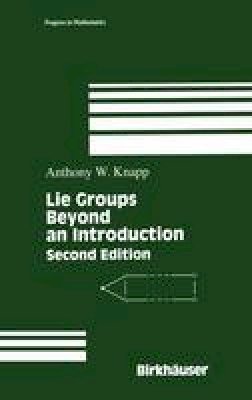
Stock image for illustration purposes only - book cover, edition or condition may vary.
Lie Groups Beyond an Introduction
Anthony W. Knapp
FREE Delivery in Ireland
Description for Lie Groups Beyond an Introduction
Hardcover. Takes the reader from the end of introductory Lie group theory to the threshold of infinite-dimensional group representations. Merging algebra and analysis, this title uses Lie-theoretic methods to develop a theory having wide applications in mathematics and physics. It includes many problems, tables, and bibliographical notes. Series: Progress in Mathematics. Num Pages: 838 pages, 1, black & white illustrations. BIC Classification: PBF; PBG; PDE; PH. Category: (P) Professional & Vocational; (UP) Postgraduate, Research & Scholarly. Dimension: 238 x 165 x 51. Weight in Grams: 1388.
This book takes the reader from the end of introductory Lie group theory to the threshold of infinite-dimensional group representations. Merging algebra and analysis throughout, the author uses Lie-theoretic methods to develop a beautiful theory having wide applications in mathematics and physics. The book initially shares insights that make use of actual matrices; it later relies on such structural features as properties of root systems.
Product Details
Publisher
Birkhauser Boston Inc United States
Series
Progress in Mathematics
Place of Publication
Secaucus, United States
Shipping Time
Usually ships in 15 to 20 working days
Reviews for Lie Groups Beyond an Introduction
Anthony Knapp's Lie Groups Beyond an Introduction, 2nd edition, is a beautiful introduction to this area of mathematics, appropriate for a variety different audiences.... The book is well-organized with concise, focused introductions to each chapter, a very thorough index of notation, and appendices.... In addition, there are hints to the hundreds of exercises, and a section on historical notes.... Knapp's ... Read morewriting is clear, and he avoids excessive notation. The first few chapters comprise a standard introductory course in Lie theory, while numerous second courses could be taught out of the later chapters. Its breadth of coverage and extensive tables also make the book a valuable reference for researchers in representation theory. -MAA Reviews (review of the second edition) The first edition of the present book appeared in 1996, and quickly became one of the standard references on the subject.... The present edition has been perfected even further, apart from straightening occasional errors...and making various revisions throughout, by adding a new introduction and two new chapters [IX and X].... Chapter IX contains a treatment of induced representations and branching theorems.... Chapter X is largely about actions of compact Lie groups on polynomial algebras, pointing toward invariant theory and some routes to infinite-dimensional representation theory.... This is an excellent monograph, which, as with the previous edition, can be recommended both as a textbook or for reference to anyone interested in Lie theory. -Mathematical Bohemica (review of the second edition) The important feature of the present book is that it starts from the beginning (with only a very modest knowledge assumed) and covers all important topics.... The book is very carefully organized [and] ends with 20 pages of useful historic comments. Such a comprehensive and carefully written treatment of fundamentals of the theory will certainly be a basic reference and text book in the future. -Newsletter of the EMS (review of the first edition) Each chapter begins with an excellent summary of the content and ends with an exercise section.... This is really an outstanding book, well written and beautifully produced. It is both a graduate text and a monograph, so it can be recommended to graduate students as well as to specialists. -Publicationes Mathematicae (review of the first edition) This is a wonderful choice of material. Any graduate student interested in Lie groups, differential geometry, or representation theory will find useful ideas on almost every page. Each chapter is followed by a long collection of problems [that] are interesting and enlightening [and] there are extensive hints at the back of the book. The exposition...is very careful and complete.... Altogether this book is delightful and should serve many different audiences well. It would make a fine text for a second graduate course in Lie theory. -Bulletin of the AMS (review of the first edition) This is a fundamental book and none, beginner or expert, could afford to ignore it. Some results are really difficult to be found in other monographs, while others are for the first time included in a book. -Mathematica (review of the first edition) The book is written in a very clear style, with detailed treatment of many relevant examples. . . . The book is eminently suitable as a text from which to learn Lie theory. -Mathematical Reviews (review of the first edition) The important feature of the present book is that it starts from the beginning (with only a very modest knowledge assumed) and covers all important topics... The book is very carefully organized [and] ends with 20 pages of useful historic comments. Such a comprehensive and carefully written treatment of fundamentals of the theory will certainly be a basic reference and textbook in the future. -Newsletter of the EMS (review of the first edition) It is a pleasure to read this book. It should serve well different audiences. It perfectly suits as a text book to learn Lie theory, including Lie groups, representation theory, and structure theory of Lie algebras. The absense of misprints and errors as well as the long collection of problems including hints at the back of the book make it suitable for self-study. . . At the end there are a lot of enlightening historical remarks, references, and additional results which can serve as a guide for further reading. The book has two good indices. Specialists will be able to use it as a reference for formulation and proofs of the basic results but also for details concerning examples of semisimple groups.
-ZAA Show Less

